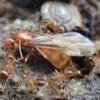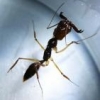I'm pretty sure they're subterranean and get their food by raiding nearby colonies for brood.
Wtf?! They don't raid for brood! They steal other colonies food. Hence their name Theif Ants
Nah, they do in fact steal other ant brood, although Solenopsis fugax is even more specialized on that.
They dig small tunnels into other ant colonies (the other ants can't pass them because Solenopsis molesta/fugax are so tiny) and have a special deterrent chemical they spray over the brood and food of the other colony, so the other ants avoid them. When most of the other ants are gone the thief ants can safely break up and transport the brood to their own nest.



















